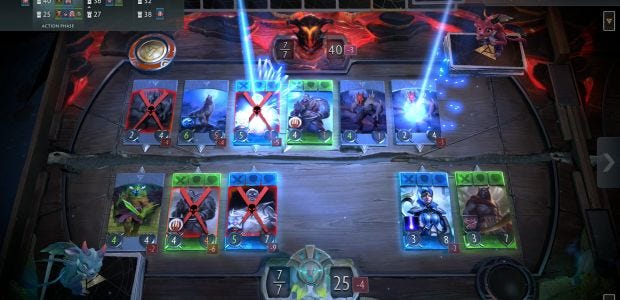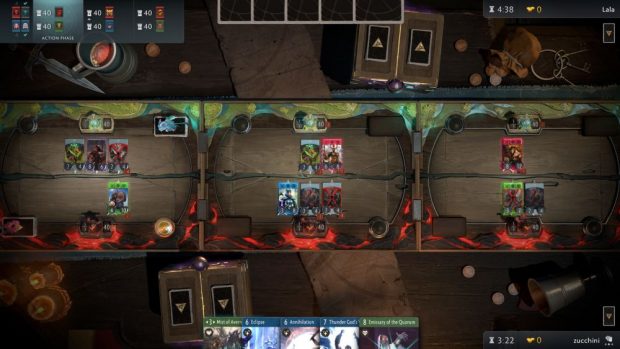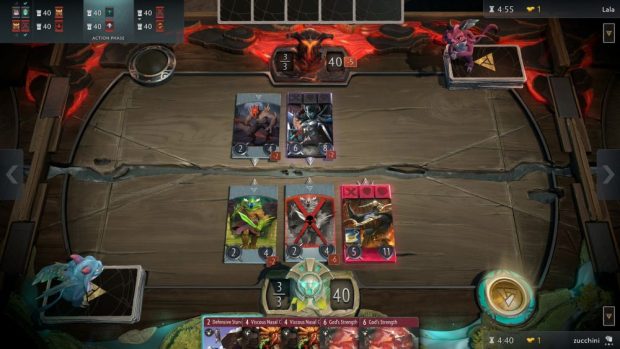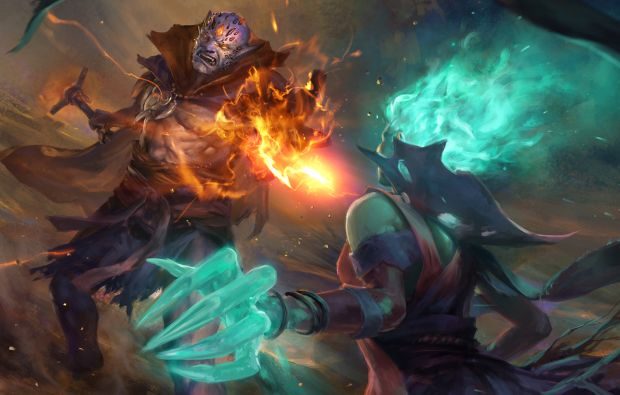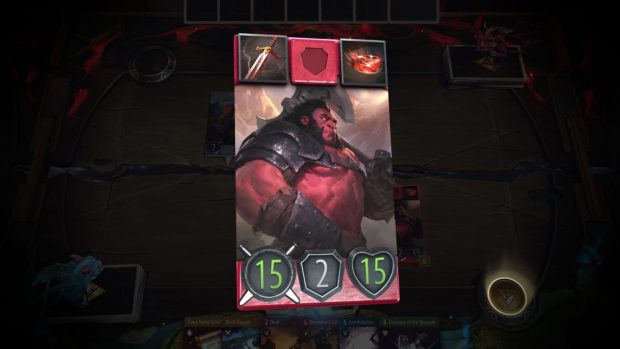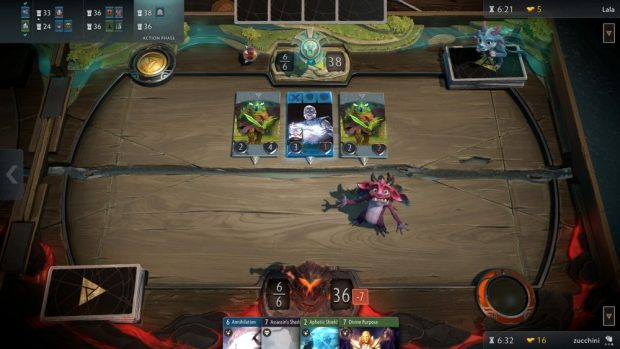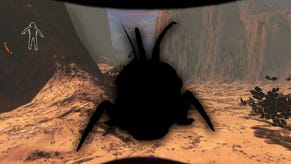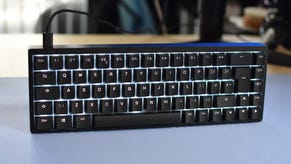Artifact pairs the best ideas of Dota with the best parts of card games
Lane down your cards
You'll often see characters in sci-fi stories play seemingly incomprehensible games like multi-dimensional space chess, and that's basically what it's like playing Artifact, Valve's upcoming Dota-inspired card game. It's an ambitious hybrid of the studio's MOBA and Magic: The Gathering, and it works shockingly well. So much so that it only took two games for me to understand and get on board with Valve's vision.
We'll get to all the rules in a bit, but for now just know that Artifact's game board is, like Dota, split into three lanes. In my second game, I played a blue/green deck against a red/black AI, and after just a few turns, it felt like I was playing three wildly different games at once. In my left lane, I used green heroes and buffs to build up a swarm of creeps and overwhelm my opponent - you know, like an aggro deck. In the middle lane, I used my blue resources to slow my opponent down and buy time for big removal spells, like a control deck. And in the right lane, I used a mix of green and blue to match my opponent move for move, taking value trades like a midrange deck.
It was one of the most dynamic and demanding things I've ever played, and while I was gutted when my demo ended, I was also excited to talk to Artifact programmers Bruno Carlucci and Jeep Barnett, who, god bless them, shepherded me through my first two games. It's a good thing I wasn't alone: in no small part because it's so different from other card games, Artifact is overwhelming at first, although some of the rules will feel familiar to Dota fans.
There are three lanes, and there's one enemy tower and one friendly tower in each lane. To win, you have to destroy two enemy towers. You can also win by killing the Ancient that spawns when you take your first tower, but the Ancient has 80 health while towers have 40, so you'd have to deal more damage overall. Investing too heavily in one lane also leaves you vulnerable elsewhere, so as Barnett told me, over 90 percent of games are won by destroying two towers.
I like this system because it prevents you from just dogpiling one lane, which was something I always felt forced to do in The Elder Scrolls: Legends. Even after you've taken an enemy tower, you still have to defend your tower in that lane. Similarly, you can't just give up when you lose a tower, otherwise your opponent will take your Ancient, too. The best way to win is by taking two towers, which keeps the pressure on and forces players to interact, and both of those ideas are central to Artifact.
The main hurdle for players with a card game background is that Artifact doesn't really do traditional turns. Instead, you play rounds. A round consists of acting and battling in all three lanes, starting from the left lane. You can only play one card at at time—a creep, an Improvement that gives a lane a buff or an ability, an item to equip to a hero, or a spell—because whenever you play a card, that lane's Initiative passes to your opponent. Then they play a card, then you play a card, and so on until both players have nothing else to do and you both pass. Once both players pass, the heroes and creeps in that lane fight, usually by attacking whatever's directly across from them. If there's nothing in front of them, they hit the tower.
For me, Artifact's rounds represent a happy middle ground between Hearthstone, where your opponent never acts during your turn, and Magic, where your opponent almost always does. I understand that a lot of skill goes into predicting and baiting answers from your opponent in Magic, but I hate waiting to see what they do every time you play a card. It slows games down, and it's just plain not fun to have your cards countered before they even do anything. At the same time, Hearthstone sometimes makes me feel helpless because I have no way of stopping my opponent's game plan during their turn. All I can do is wait for them to pass and then try to put out the fires as best I can.
Playing Artifact, I still got that intense back and forth, and predicting cards was still important, but I never had to pray my opponent would let me do what I wanted. The card I want to play is going to go through. Only then can my opponent respond to it, and then I can respond to them. It's a much cleaner, more comfortable chain of events that retains the exciting silliness of both players pulling out answer after answer like clowns pulling strings of handkerchiefs out of their mouths. It's common to just pass in Artifact, but when turns do heat up, by the time you're both breathless and out of handkerchiefs, shifting to the battle phase is absolutely thrilling. It's a lot like team fights in Dota in that respect.
Heroes are critical to these explosive moments because they determine what spells you can cast. Each lane has its own mana. Your lanes start with three mana and naturally gain one mana each round. But you can only spend that mana on spells of colors represented in that lane. In other words, if I want to play a green spell in my left lane, I need to have a green hero in that lane.
"The way you place your heroes is one of the most important strategic decisions in the game," Barnett said. "You can lose a game by putting a hero in the wrong lane."
A deck contains five heroes. Three are placed at the start of the game, then you place your fourth on turn four, and your fifth on turn five. From there, you'll always have access to all your heroes; you don't draw them from your deck like normal cards. When heroes die, they go to the Fountain, which acts like a respawn queue. Except for the newest hero, Rix, who respawns immediately, all the heroes I saw had a one-turn respawn timer, meaning if they die on turn four, they'll respawn at the start of turn six. When heroes respawn, you pick a new lane to put them in. It can be the same lane they died in, but heroes regularly bounce between lanes. The kicker is that hero deployment is a double-blind: neither player can see where the other is placing heroes until the round begins.
This is one of many ways Artifact creates opportunities for great players to shine. You not only have to think about your opponent's deck based on the heroes they choose and read their hand based on the actions they take, you also have to predict where they'll place their heroes. A hero moving from the middle lane to the left lane can be game-changing, as I learned when an enemy red hero did just that and bulldozed my aforementioned dude army. At the same time, this system prevents you from getting mana screwed, the classic Magic wet blanket. If you don't have access to the right colors, it's because you didn't choose, place or protect your heroes correctly. Here again, Artifact is more complex than Hearthstone but more direct than Magic, and I love that about it.
Heroes also directly determine the makeup of your deck. "Each hero has a premier spell that comes with them," Barnett explained, "and they have three included in the deck. So between your five heroes, 15 of your cards come from them. And it's a minimum 40-card deck, so the other 25 come from cards you choose."
"The premier cards are interesting because it's kind of a package deal," Carlucci added. "If you really like Thunder God's Wrath but you don't like Zeus, you don't get that option. That's part of the trade-off that you're making when including a hero."
A hero's premier cards are often just as important as they are. For example, in my second game, I was constantly fighting to protect my blue hero, Luna. I needed her alive so her passive ability could keep buffing her premier AoE spell, Eclipse, so that I could use it to clear out the middle lane. If she died, I'd have to wait a turn to redeploy her, and by then the middle lane might be too far gone.
Naturally, I pulled out all the stops. First I increased Luna's health so she'd survive attacks from enemy creeps. But then my opponent swapped a creep for Phantom Assassin, a black hero which specializes in killing other heroes, putting Luna back in check. I responded by Disarming Phantom Assassin with a blue spell, preventing her from attacking for a turn. This gave Luna just enough time to buff my Eclipse to a point that it could wipe the middle lane. And here's the strategic cherry on top: the turn I played Eclipse, I deliberately (read: with Carlucci's help) did nothing but pass in the left lane so that I could keep Initiative and make the first move in the middle lane, guaranteeing my Eclipse goes off. There are countless tactical wrinkles like this, and the skill ceiling on Artifact feels sky high.
My second game really showed me how lanes can interact, and it helped frame the themes and strengths of Artifact's four colors, which have 12 heroes and about 75 cards apiece in the starting card pool. Happily, you can include as many colors in your deck as you want. You can run five green heroes and never worry about having the right mana, or play four green heroes and splash one black hero. Or, fine, you can just play a four-color deck, you mad bastard. This limitless approach came up repeatedly during my time with Artifact. Carlucci said it best: "Generally, if you have a question like 'what's the limit on X?' the answer is that there isn't one."
Magic creator Richard Garfield is on Artifact's development team, so it's no surprise its colors feel similar to Magic's color wheel. At the same time, there are some appreciable differences. As Carlucci explained, blue specializes in disrupting the enemy with big spells and going wide on the board. There's no cap on how many creeps you can put in one lane, and blue can easily manage north of 20 at once. Red is all about hitting things hard with big heroes and controlling the battle phase by redirecting attacks and stunning enemies. Green excels at buffing little dudes and gaining additional mana to play expensive, powerful dudes. And black is all about killing enemy heroes and generating gold, which brings us to the item deck.
Gold is a separate resource from mana. You earn two gold for killing an enemy creep and five gold for killing an enemy hero. At the end of each round, you can use that gold to purchase equippable items from the item shop, which is one of Artifact's most inventive elements.
"Along with putting heroes and spell cards in your deck, you also build an item deck, which is a minimum of nine cards but can have as many as you want," Barnett said. "The cards in the middle of the shop are your item deck. With the ones on the left and the right, you get one offering per round where one is a consumable item from a set of four cards and the other can be any card. The cool thing about that is it gives you access to cards you don't own."
"All colors have specific powers and weaknesses, and the item deck sort of circumvents that," Carlucci added. "A lot of times it's correct to think of the item deck as kind of a sideboard against what you're playing against. If you're against something that has a lot of blockers, you buy a card that gives you Siege [and damages towers through blockers]. If they have a lot of Improvements, you have items that help you destroy Improvements. That's another interesting way of looking at it: not what helps your deck, but what answers it gives you."
You may have caught on that there's a lot going on on-screen in Artifact. Yet even in the early build I played, its interface was navigable and straightforward. As always, it's the little things. There's no maximum hand size, but you can scroll through your hand if it gets unwieldy. You use WASD to jump between lanes, but you can use Tab to view the entire board. If you're in the item shop or hero deployment phase, you can hide various UI elements to check the board state. It is a lot of information at once, but that's because Artifact tells you everything you need to know.
"One of the things we tried to do is make it so that you can keep track of all those things without taking notes," Carlucci said. "For example, there's a card that, whenever you play a spell, it has a chance of giving you a copy of that spell. If your opponent gets that, you actually get to see the copied card. There's no point in hiding that information. The card is there. Otherwise you'd be writing down 'one of his cards is that thing.' So it still has all that interesting tracking, but without making you do extra work for it."
Just as impressively, Artifact looks and sounds great. Creeps and heroes don't just bump into each other in the battle phase, they rear back like battering rams and collide in wonderfully animated maelstroms. Likewise, big, powerful cards have weighty effects that really sell their impact. That said, the little imp helpers are my favorite. When you start a game, your imp does a cute Yoshi flutter-kick on your deck and sends cards flying everywhere. He clings to the item shop's gold like a shy sloth. He struggles to drag your deck to the next lane when you advance in a round, and if there's nothing in play when he gets there, he looks up and shrugs as if to ask "What the hell?" The imps are total smartasses, and I love them.
More than anything, I'm blown away by how effectively Artifact translates Dota's rules and flavor. It looks effortless in action, but I have no doubt it was painstaking getting that rabbit into a different genre's hat. I can't wait to see what other tricks they have in store when Artifact releases later this year.
